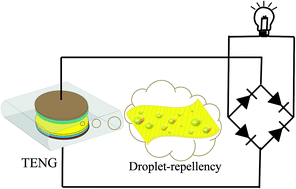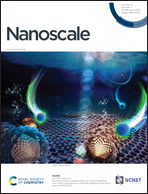Amphiphobic triboelectric nanogenerators based on silica enhanced thermoplastic polymeric nanofiber membranes†
Abstract
It is necessary to construct an amphiphobic triboelectric nanogenerator (TENG) since water, oil and other antistatic agents will have a great impact on its electrical output performance during practical applications. Herein, we put forward a high-performance TENG based on silica enhanced thermoplastic polymeric nanofiber membranes that possess outstanding droplet-repellency after being modified with fluorine-containing polymers. With in situ polycondensation of SiO2 nanoparticles on the surface of the raw materials of garment–thermoplastic nanofiber membranes fabricated by the melt-blending extrusion method, the electrical output performance of the prepared TENGs enhanced a lot, corresponding to an excellent peak power density of 2.14 W m−2 that was enough to supply several green LEDs. For improving its ability to resist moisture and antistatic agents existing in daily life, FAS/PTFE was dip-coated on the above modified membranes to achieve remarkable amphiphobicity that gave it another ability for self-cleaning. Considering the good stability of amphiphobicity and the excellent compatibility between the thermoplastic polymeric nanofiber membranes and garment, the developed TENG is believed to be the most suitable candidate for powering wearable electronics in the near future.



 Please wait while we load your content...
Please wait while we load your content...